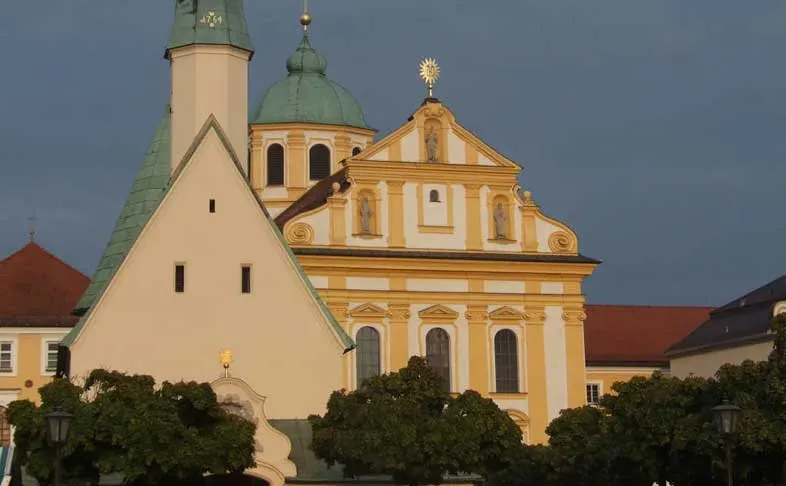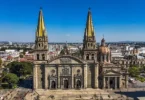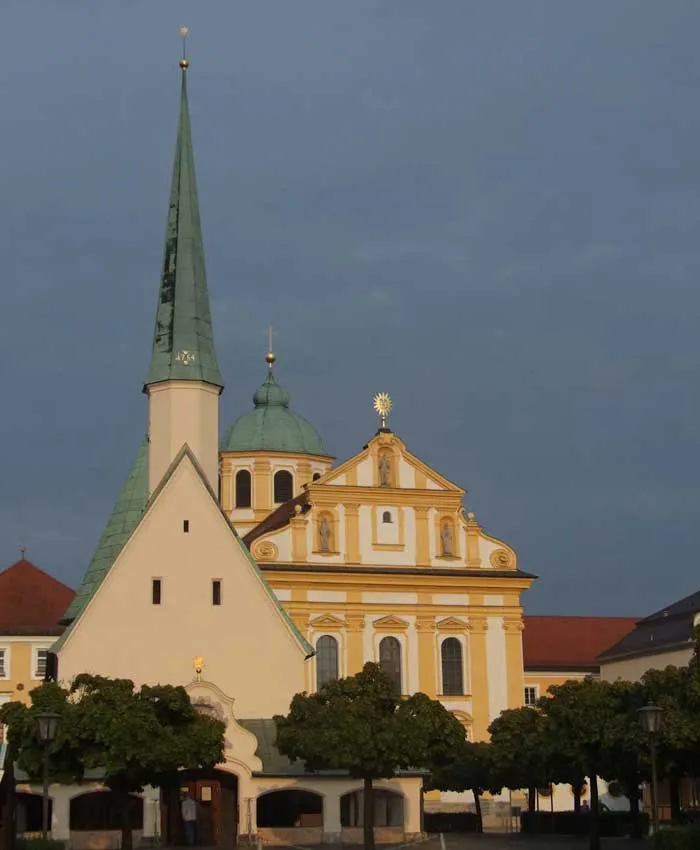
Introduction
The Shrine of Our Lady of Altötting, Bavaria also known as the Chapel of Grace (German: Gnadenkapelle), is the national shrine of Bavaria dedicated to the Blessed Virgin Mary. It is known for the many healings which are said to have taken place there, and is commonly called the Lourdes of Germany.
“It’s very profound and touching when you know that on two days a year, on “Solemnity of the Annunciation of the Lord” (Annunciation) on 25th March and on the birth of Mary on 8th September the position of the sun is exactly such that – on these two days – a ray of light falls through a small window of the chapel, which slowly wanders up over the figure of Brother Konrad in front of the altar of grace and touches the dark face of the miraculous image and illuminates it.”
The octagonal chapel which houses the image of Our Lady dates to about A.D. 660, and is the oldest Marian shrine in Germany. The image of Mary venerated there is a Black Madonna of great antiquity (possibly about 1330), carved from lindenwood. The shrine became a popular pilgrim destination when it became known for the miraculous recovery in 1489 of a young boy who had been drowned, after his mother laid his body before the image and prayed to the Blessed Mother for a miracle.
Many of the votive offerings which have been given to the shrine over the centuries are displayed in the porch encircling the church. Also to be seen are the small, silver urns in which many members of the German nobility would have their hearts placed after their deaths to be brought here.
The Shrine has been served by the Capuchin friars for centuries. One member of the Order, Brother Conrad of Parzham, O.F.M. Cap., (1818–1894) served there as porter for over 40 years. During his lifetime of service he developed a reputation for holiness and miraculous healings. He has been declared a saint by the Catholic Church.
The Shrine was honored by a visit by Pope John Paul II in November 1980. He was accompanied by Cardinal Joseph Ratzinger, who was born in a nearby town. On 11 September 2006, Ratzinger, newly elected as Pope Benedict XVI, returned to the shrine and donated the episcopal ring he had worn while he was the Archbishop of Munich. The ring is now a part of the scepter held by the Blessed Virgin.
History of the Shrine of Our Lady of Altötting, Bavaria
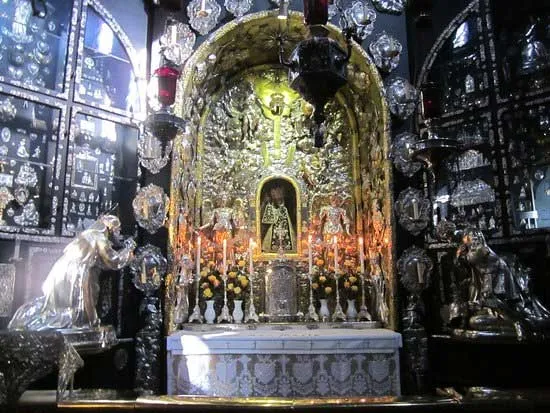
Miracle of Miracles
“A powerful means of promoting the idea of pilgrimage was at all times the printing and dissemination of reports of miracles. Those who had been heard announced it joyfully in their homeland. Many a man hung his manuscript with the report, also confirmed and sealed by high lords, on the chapel.”
Miracle Books
Miracle upon miracle occurred in the late 15th century. Century through the charitable grace of Our Lady of Altötting. Sudden, scientifically inexplicable and lasting healings were often reported. A few decades earlier, the goldsmith Johannes Gutenberg had ushered in a ground breaking turning point with the invention of the printing press. It corresponded to the modern zeitgeist that soon afterwards the miracle reports were printed in miracle books. The most famous and extensive collection was left by the Altötting canon Jacobus Issickenner in 1497 print in Nuremberg. The reporting of the miracles through the printed word spread rapidly.
“Item Joerg Eispain by Pechlerin was engraved on Pfinztag after Stephani in 93 during the night with a bread knife up to the hilt in the belly near the navel. In that he called on the mother of all graces for mercy on old Ötting. After the vow on the 10th felt nothing for a day. Has been here in the evening after Nativitatis Mariae in the 93 Year.”
The Great Miracle Boards
At the time of the first miracles, advertising was not carried out via radio, television and the Internet, but through pictorial representations that could also be understood by ordinary people without reading skills. The extension of the nave of the Chapel of Grace with the airy gallery, which took place around 1500, was equipped with 57 large late Gothic panel paintings.
The miracle tablets, which are up to two meters high, cover more than two thirds of the chapel walls. The illustrations are accompanied by textual descriptions of events from the 15th century and 16th Century supplemented. They tell in a vivid and impressive way about accidents, illnesses and natural disasters.
The unknown artist created this on behalf of the chapel administration, which one “to please the devout arriving crowd”, according to the dean of the monastery, Johann Scheittenberger, in 1520. They were intended as a direct means of pilgrimage education and promotion. It is a large pilgrimage picture book, for which one has had to tilt one’s head back and look upwards for 500 years.
“An indication of the Mother of God’s far-reaching and famous praise and encouragement newe and to covet several graces and good deeds from her; such things may then also happen afterwards, as can be heard from what follows.” We get it! The Jesuit makes it clear what the plaques were made for: to please the people, to bear witness, to inspire new and still greater confidence.”
Architecture of the Shrine of Our Lady of Altötting, Bavaria

The top soil was Altötting as it really was around 1489 and as understood and imagined by the people of the time. Altötting was a village with a monastery and a collegiate church and it had a ducal, royal, even imperial past. On the left of the Inn there was a Roman road from Augsburg to Wels, a second north-south from Regensburg to Salzburg with probably a bridge over the Inn west of Altötting. In the Middle Ages, this road grew into an important trade route between Venice, Villach, Salzburg, Landshut, Regensburg and Nuremberg.
The wonders of Altötting could travel everywhere in a short time via these roads. The first miracle happened in 1489, so in the next few years pilgrims will come from Bohemia, Vienna, Carinthia, Styria and South Tyrol. Dr. Robert Bauer (Altöttinger Pilgrimage Rector 1956 to 1991) in his recommendable book“ Bavarian Pilgrimage Altötting” laid.
From Prelate Dr. Bauer is also the source of the statement that the great miracle of Altötting is that the pilgrimage to Altötting has remained alive to this day.
Origin of the Miracle of Altötting
While the origin of the Holy Chapel octagon is more mythical than factual, the beginning of the pilgrimage can be pinpointed to the year. It was the year 1489 when the dean Johannes Scheiternberger was able to report the following miracle according to old sources: A three-year-old boy fell into the water and was only rescued half an hour later. With great trust in God, the mother carried the dead boy into the Holy Chapel and laid the child on the altar. On their knees, the mother and a few other prayers beg for the life of the child.” Soon the child will come to life” is the conclusion of the miracle report.
A miracle rarely comes alone and so in the same year the news of 2 Miracle of Altötting the round in Bavaria: A farmer was busy harvesting the oats in the field in the area around Altötting and wanted to drive a truckload full home. The farmer put his six-year-old son on a hand horse. The horse was frightened by the sheet lightning of an approaching summer storm and the boy fell under the carriage, which was being pulled by the running horses.
The boy is run over by the heavily loaded wagon and so “crushed” that he was closer to death than life. In human terms there was no more hope. Nevertheless, a vow was made and the Mother of God was asked for help. “The next day the boy is again very fresh and healthy,” is the sound across the country and far beyond the national borders.
Through the convincing belief in the powerful miraculous activity of the Altötting miraculous image, the well-founded hope for further miraculous help spread, of whose vitality the votive and miracle tablets around the Chapel of Mercy report to this day.
The appearance of the Holy Chapel is characterized by the octagon, an octagonal building with a pointed dome, the origin of which has not been proven to this day. However, there are many myths and legends about its origin. The construction was first mentioned in writing in 877. Perhaps it was the baptistery of the monastery founded by King Karlmann in Altötting.
The depiction of the octagonal chapel with an enthroned Madonna in the town seal of the neighboring town of Neuötting from the 13th century. In any case, the 19th century testifies to the special importance of the building in ancient times.
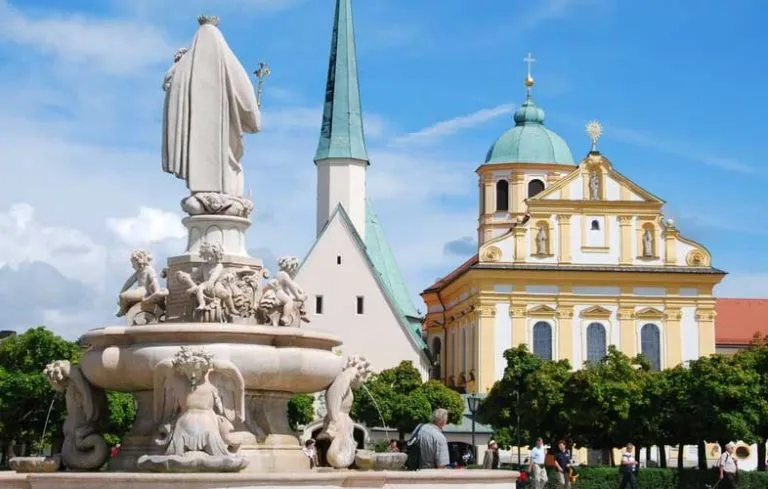
The Longhouse
A nave with a church tower was added to the west of the octagon. The nave was created after the pilgrimage began through the first miracles in 1489 and was already there in 1497.
The plans of Elector Ferdinand Maria (1651 − 1679) to build a cupola over the chapel were discontinued due to lack of funds. The design by court architect Enrico Zuccali can be seen in Pope Benedict XVI house. Admire the treasury and pilgrimage museum. The construction of the Holy Chapel remained unchanged and has retained its unique charisma to this day. Only the extensive Kapellplatz around the small church has changed its appearance over the centuries.
The Handling
Around the church building, an arcaded walkway invites pilgrims to pray at any time. Over 50 great miracle pictures and around 2000 Votive tablets testify to the powerful help of the Mother of Grace from Altötting. Wooden crosses stand ready on the north side of the chapel. These are carried by worshipers around the Chapel of Grace.
Carrying the cross accompanies the heartfelt prayer in the concerns of the praying person in the trust of being heard. In addition, crutches, prostheses and other votive offerings testify to heavenly help. The large Stocker cross is also a witness to a wonderful answer to prayer – but this is a separate story that can be purchased as a small booklet in the sacristy of the Holy Chapel for a fee.
The Sacred Space
One enters the interior of the octagon through a late Romanesque portal and under the protective cloak Madonna. The gilded altar of grace shines in the candle light and immediately draws the eye. The image of the Mother of Graces in her shrine above the silver tabernacle is the focal point, framed by numerous silver figures as a symbolic story. Silver and gold – the colors of God and Mary are art fully combined in the altar piece.
The Madonna of Altötting (The Mercy Statue)
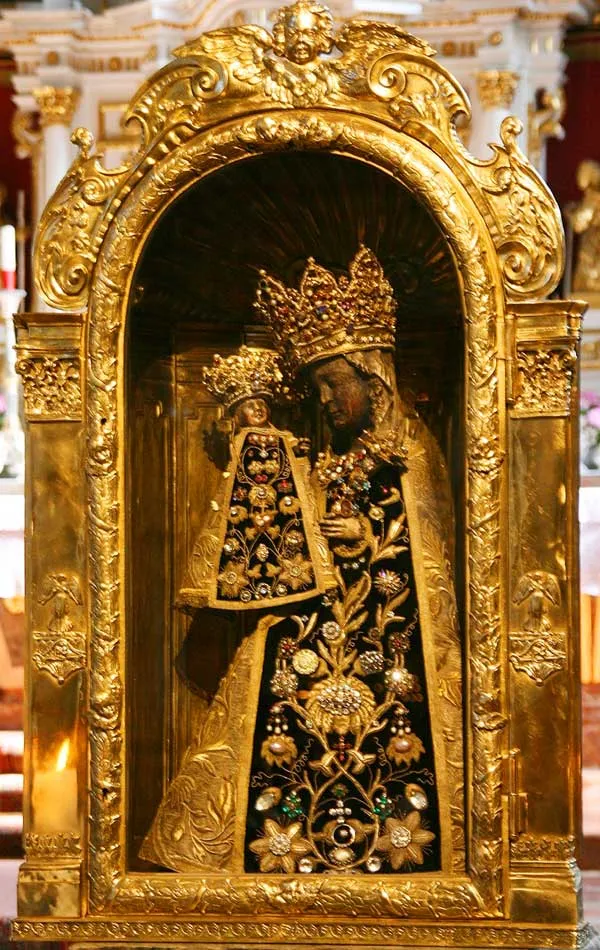
The world-famous Altötting Madonna, the so-called “Black Madonna”, is actually at the root of the most important Marian pilgrimage site in German-speaking countries. Every year about one million pilgrims come to Altötting to present their troubles and trials but also their thanks to Our Lady of Altötting at the Gnadenkapelle [Chapel of Mercy].
The statue of Our Lady of Altötting was carved in the early Gothic style in the Upper Rhine region around 1330 and is made from lime tree or coniferous wood. According to historical tradition, the Altötting Madonna came to Altötting via the Raitenhaslach Cistercian monastery.
The 66 cm large miraculous image is made of linden wood, comes from Burgundy and was brought to Altöting via the nearby Raitenhaslach Cistercian monastery. Since 1518 mother and child have been dressed in preciously embroidered garments.
The dark coloring of the face and hands has given the miraculous image its title in the vernacular “Black Madonna” introduced. The sole reason for the discoloration is the sooty smoke from the altar candles, to which the image was exposed for many centuries. The patination of the integrated silver chandelier has also reinforced this optical effect. The Blessed Mother’s gentle, sweet countenance – smiling with motherly understanding- has attracted millions of people.
The beautifully created wooden image refers to our mother in heaven, who wants to guide us through the earthly valley to our eternal home. Hidden under the miraculous image in the altar of grace is the letter of consecration from Elector Maximilian I, in which he consecrates himself and the whole of Bavaria, written in his own blood, to the Blessed Mother.
“If an image, of wood, righteously carved and simply painted, helps the two or three to come together in the name of the Lord and for the glory of his mother, then it is an image of grace.”
Special Features of the Miraculous Image
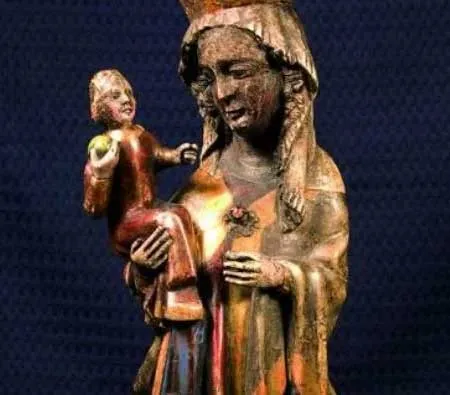
In her left hand, Mary holds a sceptre with a lily blossom as a sign of her virginity. The Child Jesus rests on her right arm and carries a celestial sphere representing the omnipotence of God. Since the Baroque period, both Our Lady of Altötting and the Child Jesus have worn elaborate crowns adorned with precious stones. These treasures were often donated by female members of the royal Wittelsbach family.
In addition to the natural darkening process of the wood, the Altötting Madonna is blackened by the soot of all the candles lit throughout the centuries and is therefore revered as the “Black Madonna”.
Clothing Of The Madonna Of Altötting
The Altötting Madonna has been dressed in exquisite robes, the so-called “Gnadenröckln” [skirt of mercy], since 1518. The robes are changed depending on the liturgical festival concerned. After their wedding, which was traditionally preceded by a pilgrimage to Altötting, the Wittelsbach princesses often sacrificed their wedding dresses to have valuable Gnadenröckln made for the Madonna.
Particularly precious specimens can be admired at the pilgrimage museum. In 2017 a new purple Gnadenröckln for the Lent season was donated to the Altötting Madonna by a lady wishing to stay anonymous.
The "Pope’s Ring" of the Miraculous Image

Since 11 September 2006 the sceptre of the Miraculous Image has been adorned with a very special ring. During his pastoral visit to Altötting, Pope Benedict XVI also prayed to Our Lady of Altötting at the Gnadenkapelle and gifted his bishop’s ring to the Altötting Madonna, the patroness of Bavaria, as a sign of his deep devotion to the Virgin Mary and attachment to the Marian shrine. It is an amethyst set in gold presented to him by his siblings Mary and George on the occasion of his episcopal ordination in Munich in 1977.
Heart Burials
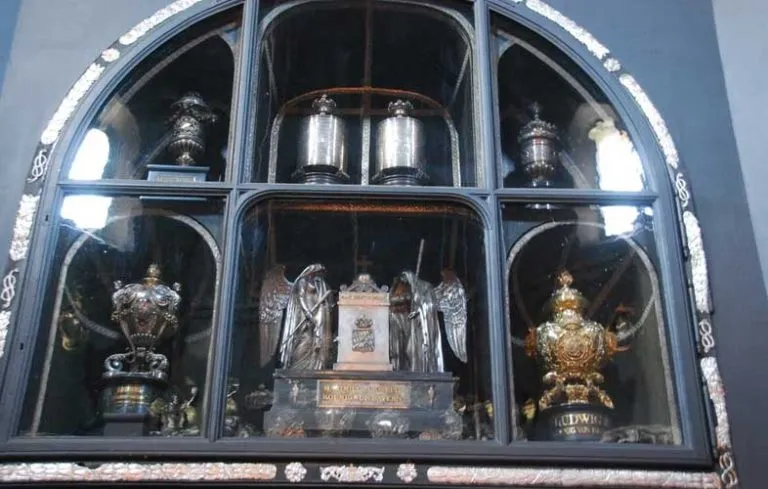
A total of three burials (1633, 1634 and 1666) took place in the chapel of grace. In addition, 28 heart burials took place over a period of more than 300 years:
- 1 Emperor
- 6 kings
- 3 Bavarian Electors
- 2 other princes
- 11 princely women
- 5 bishops
13 heart urns are walled in or under the pavement and are therefore not visible. 14 urns with a total of 15 hearts are exhibited in wall niches.
A Gilded Silver Vessel with Rock Crystal

Crown Prince Rupprecht of Bavaria, By order of Duke Albrecht of Bavaria, a gilded silver vessel with rock crystal is exhibited instead of a heart urn. The hearts of Elector Karl Theodor’s mother and King Maximilian I, Joseph’s mother were made at the request of the House of Wittelsbach in 1983 Recorded in the Chapel of Mercy. You are behind the altar.
The urns are made of tin or copper, as usual, and are unadorned. The urns set up in the wall niches are exclusively made of silver, gilded and decorated with precious stones. The number of heart urns of this material and artistic quality in one place is unique in the world.
In addition to the heart, the internal organs were also developed“ Intestina” of the Electress buried in the Chapel of Mercy.
The term “Altötting – Heart of Bavaria” does not refer to the fact that most heart burials took place here, but to the fact that the place has been the Christian religious centre of Bavaria for centuries. At this point, the episcopal administration of the Kapellstiftung would like to thank Mr. Christian Strauss, city guide in Altötting, for compiling the above information.
Pope Pius VI as a pilgrim in Altötting
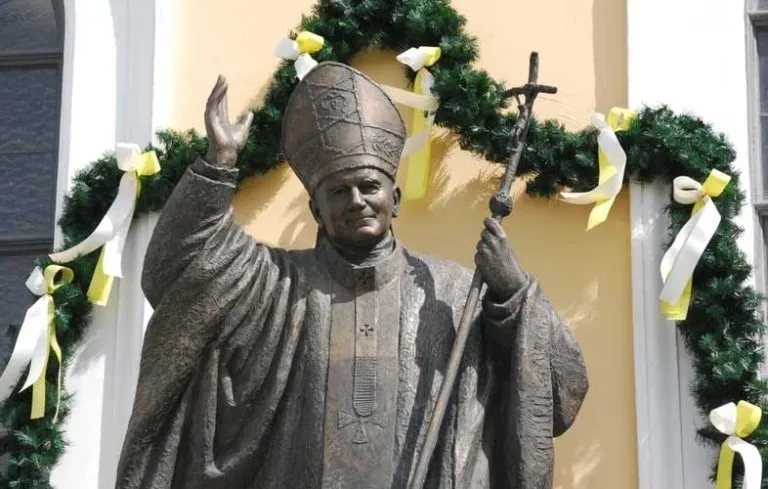
Altötting and the popes, that’s a long story that didn’t start with Pope John Paul II has begun. Almost exactly 200 years before him, a pope stayed in Altötting as a pilgrim.
Let’s go back to the year 1780. Empress Maria Theresa died in Vienna. After her, her son Joseph II mounted the throne, which entertained far-reaching ideas for the renewal of the state and immediately began to implement them, which were to cut deeply into the rights and life of the church. Pope at that time was Pius VI (1775 − 1799). He made one more rescue attempt and traveled in the spring of 1782 to the Emperor in Vienna.
The emperor was friendly and polite to the pope — but also deaf to his concerns. And the people at court who advised the emperor, above all the chancellor, Prince Kaunitz, treated the high guest arrogantly, ruthlessly and with undisguised contempt. So the Pope left on the 22nd April Vienna with destination Munich. There he wanted to meet the new Bavarian Elector Karl Theodor, who had already been his guest in Rome and from whom he expected more understanding.
The pope and his entourage reached. April Ried, where Thurn-und-Taxis’ Councilor Joseph von Blank received the distinguished guest and accompanied him to Altötting. There he met on the 25th April 1782 in the evening around five o’clock.
There the Hegnenberg infantry regiment with 500 men was drawn up on the Kapellplatz and fired three times “General salute” as the Pope dismounted at the Holy Chapel, where he and his entourage were greeted by the Archbishop of Salzburg, Hieronymus Graf von Colloredo, Prince Wilhelm von Birkenfeld, who had been sent to Altötting by the Elector, and the entire government of Burghausen and the chapter “with all the bells ringing” and led to a short prayer in the Chapel of Mercy to the singing of Benedictus and Te Deum.
Then the pope and his companions went to the collegiate church and inspected the treasury. Then the pope moved into his domicile in the priory next to the parish church.
Feast Day – 14th May
Annual Feast day of Our Lady of Altotting also known as Our Lady of Bavaria held on 14th May.
Church Visiting Time
- Mondays : 8:00 am to 2:00 pm
- Tuesdays & Wednesdays : 8:00 am to 12:00 (Noon) & 1:00 pm to 5:00 pm
- Thursdays : 8:00 am to 12:00 (Noon) & 1:00 pm to 6:00 pm
- Fridays : 8:00 am to 12:00 (Noon)
- Saturdays & Sundays : Closed
Contact Info
Kapellplatz, 84503 Altötting,
Bavaria, Germany.
Phone No.
Tel : +49 8671 9242014
Accommodations
How to reach the Shrine
Salzburg International Airport is situated to the south of Altötting, Germany is the nearby airport to the Shrine.
Altötting Train station in Altötting, Germany is the nearby train station to the Shrine.

